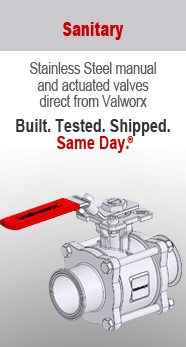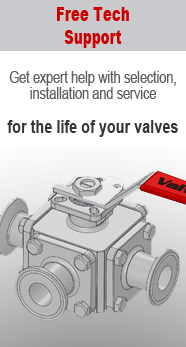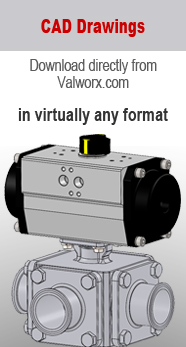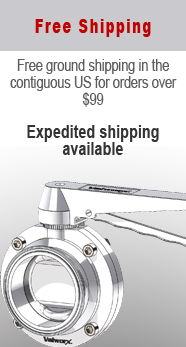Sanitary
Learn About Sanitary Valves
Sanitary valves must meet specific health & safety standards for food, beverage, medical, and pharmaceutical industries where it is critical to maintain the purity of the consumable product. Unlike other valve-types, sanitary valves must endure frequent assembly, reassembly, and installation which will allow the valve to be cleaned to the microbial level.
In particular, sanitary valves are designed to mitigate risk from biological, chemical and physical hazards. Biological hazards include microbial pathogens such e coli and listeria, as well as parasites and spoilage organisms. Chemical hazards include toxic substances such as lead or arsenic, and physical hazards can come from unintended introduction of metal or glass and other harmful substances.
To meet these requirements, the materials and finishes for sanitary valves are typically 304 or 316 stainless steel, a non-toxic metal that is polished to a clean, smooth surface that is resistant to degradation and corrosion. Threaded connections are generally prohibited as they are difficult to clean to a microbial level. In addition, all O-rings, seals, and seats used with sanitary valves must be constructed of inert, abrasion-resistant materials such as PTFE (Teflon).
Sanitary Valves are classified into three types that are based on the valves mechanical motion as outlined below.
- Linear Motion - utilize a closing member and move in a straight line to start, stop, or throttle the media flow. (i.e.: Gate, Globe, diaphragm, and check valves)
- Rotary Motion - utilize a valve-closure member that moves across an angled or cylindrical path (i.e.: butterfly, ball, plug, eccentric and swing check valves)
- Quarter-turn Motion - rotary-type motion valves that only require a quarter-turn (0° - 90°) stem motion to go from fully open to fully closed and vice versa
Sanitary ball valves are constructed of stainless steel and inert sealing materials and are available in 2-way and 3-way configurations.


The geometry of ball valves is such that there is an undesirable "dead spot" between the valve seat and ball where bacteria could grow. To eliminate this, sanitary ball valves typically have "cavity-filled" ball seats where this space is surrounded with virgin PTFE.
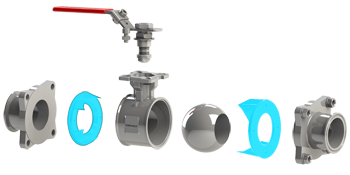
The product contact surfaces are polished to a minimum roughness of 32 Ra, although Valworx valves are further polished to an 8-12 Ra. Instead of threaded connections, sanitary ball valves use either welded or tri-clamp connections. Valworx valves are all tri-clamp connections.
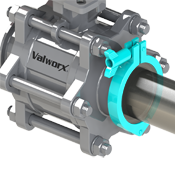
Sanitary ball valves can be designed to be easily actuated. Actuators can be attached to the valve stem using couplers and brackets, or the valve itself can have an actuator mounting pad. Valves of this type are referred to as "direct mount", and they eliminate the need for brackets. Available actuators for sanitary ball valves include:
- Electric - On/Off
- Electric - Positioner
- Electric - Multi-Voltage
- Air - All Stainless
- Air - Scotch Yoke
- Air - Rack & Pinion
Sanitary butterfly valves use the same design principle as regular butterfly valves, flow is controlled by turning a disc instead of a ball, but incorporate sanitary design such as tri-clamp fittings, a high degree of polish, and suitable materials of construction.

Valworx sanitary butterfly valves are forged 316L stainless steel body / disc with product contact surfaces polished to 32 Ra. The elastomeric valve seat is EPDM.
Like their regular butterfly counterparts, sanitary valves are a lower cost alternative but are rated for lower maximum pressure. Valworx valves have a maximum pressure rating of 160 psi.
Sanitary butterfly valves are ideal for food, beverage, beer brewing, bio-pharmaceutical, and fine chemical industries along with utility, process, and corrosive applications. However, EPDM should not be used for applications involving lipids of more than 8%.
Valworx sanitary butterfly valves are approved for food contact by the FDA and may also be used in applications where hygienic construction is required. Sanitary butterfly valves may be actuated utilizing brackets and couplers. While individual bracket designs may vary, in general the simpler the design the better.

Available actuators for sanitary butterfly valves include:
- Electric - On/Off
- Electric - Positioner
- Electric - Multi-Voltage
- Air - All Stainless
- Air - Scotch Yoke
Sanitary check valves allow flow in a single direction only. The major types of check valves are swinging gate and concentric spring. The former uses a hinged disc that opens with upstream pressure and closes upon reverse. Swing check valves are generally not used in sanitary applications due to clean-ability issues.
Concentric spring check valves use a spring-loaded disc that retracts when the upstream fluid pressure exceeds the disc cracking pressure to allow fluid to pass. They can be used in vertical and horizontal applications (check valves should never be installed at an angle). Vertical installations with the fluid flow downward must consider the static head pressure vs the valve cracking pressure.
Concentric spring check valves are suitable for horizontal applications that do not require self-draining. For self-draining applications, eccentric check valves should be used.
Like ball and butterfly valves, sanitary check valves incorporate sanitary design including 316L stainless construction, Viton seals (optional silicone seals available), tri-clamp connections and highly polished internals (32 Ra).
Check valves are passive devices and therefore require no external energy source or actuation.
Sanitary valves are indispensable components in hygienic manufacturing. With proper design and cGMP thereafter, sanitary valves are safe and reliable. Depending on valve type, sanitary valves can be used in food, pharma, beauty, beverage, brewing, pet and medical applications. In short, wherever safe, sterile fluid control is required.





